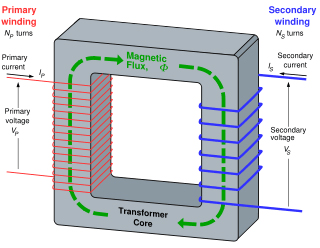Electrical Transformer
Do you know what is a Transformer?
A transformer is an electrical device designed to transfer alternating current or voltage from one electric circuit to another by means of electromagnetic induction. Electrical transformer converts AC voltage from one value to another. It can be designed to "step-up" or Step-down" voltages.
The simplest type of transformer consists of two or more coils of insulated wire wound on a laminated steel core. When voltage is introduced to one coil, called the primary, it magnetizes the iron core. A voltage is then induced in the other coil, called the secondary or output coil. The coils are primary and secondary and function as conductors. The change of voltage between the primary and secondary depends on the turns ratio of the two coils. The amount of electricity being produced depends on the number of times the coil is wound around the core. The more times it's wound around, the higher the voltage. So if the input coil has more loops and the output coil has a couple of loops, the input coil will be a higher voltage than the output coil. If the coils have an equal number of loops, their input and output will be equal. If the output coil has more voltage, it's called a "step-up transformer." If the input coil has more voltage, it's called a "step-down transformer." Electric transformers are comprised of sets of coils or windings linked by a magnetic field. When the primary coil receives AC voltage, this produces a varying magnetic field of voltage surrounding the conductor. The primary coil is responding to the fluctuating current of AC voltage. The magnetic field activates the secondary conductor coil. This results in the transformers changing the voltage and transferring electrical energy. The number of windings on each coil is important as this determines the voltage that is conveying from the primary to the secondary through the magnetic field. The number of windings or turns in the primary coil to the number of turns in the secondary coil determines the magnitude of the voltage. The core is typically iron as this produces the most efficient magnetic coil. Electrical transformers can also serve to isolate parts of circuits from others. Power transformers have various configurations according to phase and connections. The most common phases are single-phase and three-phase. Both the size and expense of electric transformers increases in proportion to the number of primary windings.
Transformers utilize inductance to step-up or step-down voltages. The construction of a transformer consists of two separate coils of wire wrapped around a core of iron, air, or any ferromagnetic material. While iron and ferromagnetic cores provide much higher coupling (efficiency of induction transfer), there are significant losses through heat generation in the core. Cores can also be shaped differently, such as the rod and E-core designs.
Transformers are not limited to one output coil. They can provide a whole range of voltage sources from the one input coil by using separate windings on the secondary side. This makes transformers very useful for supplying complete systems with all of their voltage requirements from one source.
A transformer has no moving parts and is a completely static solid state device, under normal operating conditions, are usually insure a long and trouble-free life.

How Dry type Transformer Works?
A dry type transformer, like all transformers, uses basic physical principles of electricity and magnetic coupling to produce any desired voltage level:
- When a fluctuating electric current flows through a wire, it generates a fluctuating magnetic field or "magnetic flux" all around it.
- When a magnetic field fluctuates around a piece of wire, it generates an electric current in the wire.
So, if a second wire is placed next to the first charged wire, within that fluctuating magnetic flux field, electric current is induced to flow in the second wire. Thus, electricity is “passed” from the first wire to the second without the two wires actually touching. In all transformers, including dry type transformers, the first wire, or primary coil winding, is connected to an alternating current (AC) voltage source while wrapped around a magnetic core, producing a fluctuating current in the wire coil. That fluctuating current magnetizes the core. The second wire coil, or secondary winding, is wrapped around another part of the core. The fluctuating magnetic field in the core induces a current in the secondary coil. The relative number of turns each winding makes around the core determines how much voltage is produced in the secondary. Most commonly, transformers step voltage down from high to low; but turns ratios can also be arranged to step up voltage if necessary, for instance, to allow 240-V foreign appliances to work in the US where the voltage supplied is 120 V.
- Go back to the previous page.
- Use the search bar at the top of the page to search for your products.
- Follow these links to get you back on track!
Store Home | My Account

 United States
United States